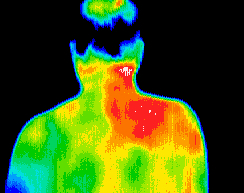Thermography
Medical Thermography
Digital Infrared Thermal Imaging (or DITI) is a non-invasive clinical imaging procedure used to detect and monitor many diseases and physical injuries. The images generated by the infrared scanning device allow a certified examiner to visualize and quantify changes in skin surface temperature. The scanning device converts heat (infrared radiation) emitted from the skin surface into electrical impulses that are displayed in color on a monitor. This visual image graphically maps the body temperature of an individual (this image is called a thermogram). The spectrum of colors indicates an increase or decrease in the amount of heat emitted from the body surface. Since there is a high degree of thermal symmetry in the normal body, subtle abnormal temperature asymmetries are identified easily by a trained clinician. (Source: American College of Clinical Thermology: ACCT)

In Sports Medicine, DITI has been helpful as a diagnostic tool in the differential diagnosis of neuromusculoskeletal injuries and their prognosis for return to participation and competition. DITI helps confirm a diagnosis and can be used as a gauge to clinically assess progress and treatment response, as well as being a prognostic indicator.
DITI is useful for the diagnosis and treatment of:
One of DITI's biggest contributions to sports medicine is in the detection of the post-traumatic pain syndromes of reflex sympathetic dystrophy (complex regional pain syndrome) and sympathetic pain syndromes which can occur after minimal injury. These have traditionally been difficult to diagnose. DITI provides an invaluable window into the autonomic/sympathetic nervous system, which records via somatic cutaneous reflex, the sympathetic response to pain and injury. (Source: Meditherm )
Indications for Thermographic Evaluation

